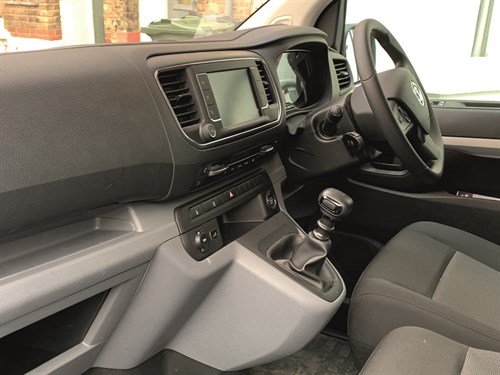- Inseego awarded Crown Commercial Service framework status
- ADVERTISEMENT FEATURE: Electrify and optimise: Digital solutions at the forefront of decarbonisation
- Fleets being pushed to take electric vans due to ZEV mandate, AFP reports
- Buying a used... Citroen Relay (2019)
- Fleetfind joins Fleetcheck affinity programme
- New LCV market growth continues, but EVs see steep fall
- Innovation award for Runyourfleet
- Orders open for Ineos Grenadier Commercial
- Toyota Hilux range gains new rally-inspired GR Sport II variant
- Remarketing: Pick of the bunch
Vauxhall Vivaro long-term test – Final Report
Date: Friday, June 24, 2022 | Author: James Dallas

2nd Report
My first few weeks with the Vivaro double cab have been spent in urban environments and on the whole it is proving to be something of a manoeuvrable and civilised van about town.
A reasonably quiet engine (although the 2.0l tested here is noisier than the 1.5 in the range) means it goes about its business discreetly and a roof height of 1.9m makes nearly all city car parks easily accessible.
The L2 double cab is 5,309mm long but a wall to wall turning circle of 12.9m means it is passably nimble in tight situations. By way of comparison, this is fractionally wider than the 12.8m turning circle of the Vauxhall van’s arch rival, the Ford Transit Custom Limited double-can in van.
Reach and height adjustable hydraulic steering with electrical power assistance takes the strain out of the frequent changes of direction that are part and parcel of city driving and an efficient stop/start system obediently cuts off the engine at junctions and traffic lights.
The suspension employs MacPherson struts and an anti-roll bar at the front along with coil springs and gas pressure dampers at the rear. The result is a ride that feels well-supported but softish and comfortable enough when negotiating speed humps and, increasingly the potholes that populate London’s streets.

An interior bonus with the flagship Elite specification Vivaro is the head up display, which allows the driver to keep their eyes on the road while checking speed and satnav directions, for example. On other trim levels the head up display is available as a £990 option, and that’s excluding VAT.
The driver’s seat is six-way adjustable and comes with adjustable lumbar support and an armrest, which should make it easy enough to find the best driving position. A quirk of the Vivaro however, and also of the medium vans built on the same platform: the Citroen Dispatch, Peugeot Expert and Toyota Proace, is the off-centre driving position that places the steering wheel to the left of the seat and the pedals to the right. This is more than a little disconcerting at first although it has to be said you do get used to it. I have suffered no ill effects over the short distances I have covered so far but suspect it may be a different and less comfortable story once I have undertaken longer journeys in such an ergonomically-compromised driving position.
Another downside is that the cabin can feel cramped and dark due to small windows and a high dashboard. At night it is difficult to see the buttons and dials on the dashboard as they are poorly lit.
Turning to storage, the glove box is a decent size but not lockable and sits above a cubby hole for odds and ends. The door bins are generously proportioned and there is a lidded tray on top of the dashboard. The space below the 7in touchscreen though, is too small to hold a modern smartphone and some of the other storage surfaces are too narrow and shallow to be of much practical use.
Finally, as is so often the case with front bench seats, the moulding for the gearstick bows out into the cabin, encroaching into the middle-seat passenger’s legroom (obstructing the right knee, to be precise), thus rendering unfeasible anything other than short journeys with three in the front.
Report card: Cabin = 3/5
Generally comfortable but let down by some impractical storage facilities and an odd driving position.
Vauxhall Vivaro doublecab Elite 3100 L2H1 2.0 150hp
Mileage 555mls
Official combined fuel economy 31.8mpg
Our average consumption 31.3mpg
Price range (ex VAT) £24,378-£30,518
Price (ex VAT) £30,518
Warranty 3yrs/100,000mls
Service intervals 30,000mls
Load length 2,365mm
Load width (min/max) 1,258mm/1,636mm
Load bay height 1,396mm
Load volume 4.0m3
Gross payload 1,245kg
Engine size/power 1,997cc/150hp
Gearbox 6-spd manual
CO2 143g/km
View The WhatVan Digital Edition


